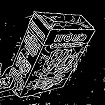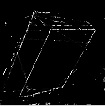Understanding Hough transform
When you read a description of this popular method, you will most probably see the characteristic illustration with many sine curves crossing at one point. This explanation goes from image space to Hough space. One input pixel is represented by one sine. This approach is a bit weird and difficult to understand for new students. Why not go in opposite direction? Let's take 1 dot in Hough space. What does it represent? 1 line on the image. We can fill the corresponding bin of the accumulator by moving along this line and checking whether all pixels are in place. This straightforward approach has not only pedagogical advantage. It opens ways for various modifications. For example, we can easily join benefits of standard and probabilistic Hough. That is, we can just count pixels or also trace segments. I have even created a variant which can detect lines on noisy background - something that probabilistic Hough is unable to do.
 -->
--> 
What can you say about it?
